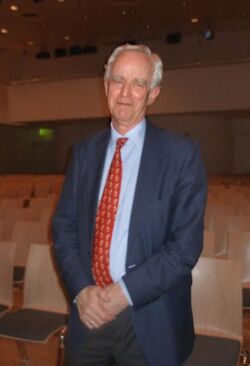Biography:Pim van Lommel
Pim van Lommel | |
|---|---|
 Pim van Lommel | |
| Born | Pim van Lommel Laren, North Holland |
| Nationality | Dutch |
| Education | Medicine |
| Alma mater | Utrecht University |
| Known for | Near-death experiences |
| Scientific career | |
| Fields | Cardiology |
| Institutions | Rijnstate Hospital |
Pim van Lommel (born 15 March 1943) is a Dutch author and researcher in the field of near-death studies. He studied medicine at Utrecht University, specializing in cardiology. He worked as a cardiologist at the Rijnstate Hospital, Arnhem, for 26 years (1977-2003). In 2001, his large-scaled prospective study to the near-death experiences after cardiac arrest was published in the medical journal The Lancet.[1] In 2007, the first (Dutch) edition of his bestseller "Consciousness Beyond Life: The Science of the Near-Death Experience," was published.[2]
Reception
Neurobiologist Dick Swaab praised Lommel's research for mapping patients experiences and opening up the subject of near-death experiences (NDE's) to the medical world. But he also claimed that Lommel's book ignores scientific knowledge, including some conclusions from his own research. He further argued that Lommel does not refute neurobiological explanations, gives no scientific basis for his statements and borrows concepts from quantum physics without ground (Quantum mysticism). According to Swaab, Van Lommel deviates from the scientific approach and his book can only be categorized as pseudoscientific.[3]
Dutch physician and anesthesiologist G. M. Woerlee wrote a chapter by chapter examination of Lommel's Consciousness Beyond Life. According to Woerlee the book is full of "tendentious and suggestive pseudoscientific nonsense", and the picture of the functioning of the body as proposed by Lommel is not consistent with medical knowledge. Woerlee concluded that the book is a "masterly example of how tendentious and suggestive interpretation of international scientific literature, vague presentation of basic medical facts, together with ignorance of some basic statistical principles leads to incorrect conclusions."[4]
Jason Braithwaite, a Senior Lecturer in Cognitive Neuroscience in the Behavioural Brain Sciences Centre, University of Birmingham, issued an in-depth analysis and critique of Lommel's prospective study published in the medical journal The Lancet, concluding that while Lommel's et al. study makes a useful contribution, it contains several factual and logical errors. Among these errors are Lommel's misunderstandings and misinterpretations of the dying-brain hypothesis, misunderstandings over the role of anoxia, misplaced confidence in EEG measurements (a flat electroencephalogram (EEG) reading is not evidence of total brain inactivity), etc. Jason concluded with, "it is difficult to see what one could learn from the paranormal survivalist position which sets out assuming the truth of that which it seeks to establish, makes additional and unnecessary assumptions, misrepresents the current state of knowledge from mainstream science, and appears less than comprehensive in its analysis of the available facts."[5]
In his book Lommel also supported alleged psychic abilities of some NDErs. Skeptic Donna Harris in a review for the book wrote the research was unreliable as it was taken from self-reported surveys and interviews and "since any type of paranormal or intuitive power remains unproven, it is troubling that the author doesn’t question these abilities, and just includes them as accepted facts."[6]
Publications
- Van Lommel, P., van Wees, R., Meyers, V. and Elfferich, I. (2001) Near-death experience in survivors of cardiac arrest: a prospective study in the Netherlands. Lancet 358: 2039-2045.
- Van Lommel, P. (2004). About the continuity of our consciousness. Advances in Experimental Medicine and Biology 550: 115-132.
- Van Lommel, P. (2006). Near-Death Experience, Consciousness and the Brain. A new concept about the continuity of our consciousness based on recent scientific research on near-death experience in survivors of cardiac arrest. World Futures, The Journal of General Evolution 62: 134-152.
- Consciousness Beyond Life: The Science of the Near-Death Experience (2010, 2011)
- Van Lommel, P. (2011). Near-death experiences: the experience of the self as real and not as an illusion. Annals of the New York Academy of Sciences 1234: 19-28.
- Van Lommel, P. (2013). Nonlocal Consciousness. A concept based on scientific research on near-death experiences during cardiac arrest. Journal of Consciousness Studies 20: 7-48.
References
- ↑ Lommel, Pim van, Ruud van Wees, Vincent Meyers, and Ingrid Elfferich. “Near-Death Experience in Survivors of Cardiac Arrest: A Prospective Study in the Netherlands.” The Lancet 358, no. 9298 (December 15, 2001): 2039–2045.
- ↑ Lommel, Pim van. Consciousness Beyond Life: The Science of the Near-Death Experience. New York: HarperOne, 2011.
- ↑ Swaab, Dick. (2014). "We Are Our Brains: From the Womb to Alzheimer's". "However, he should not fool people by giving his book the subtitle The Science of the Near-Death Experience. Nor should he, a doctor, frighten off potential organ donors with his completely unscientific theories."
- ↑ Woerlee, G. M. (2011). "Review of Consciousness Beyond Life by Pim van Lommel". Retrieved 2014-07-12.
- ↑ Braithwaite, J. J. (2008). "Near Death Experiences: The Dying Brain". Skeptic. Volume 21, Number 2. Retrieved 2014-07-12.
- ↑ "Broadcasting from the Great Beyond a book review by Donna Harris". Retrieved 2014-07-12.
Further reading
- G. M. Woerlee. (2014). "Setting the Record Straight: Commentary on an article by Pim van Lommel". Retrieved 2014-07-12.
External links
- Personal website
- Consciousness and near-death experiences – Pim van Lommel, M.D. Article and video interview on e-ostadelahi.com
- Dutch homepage

